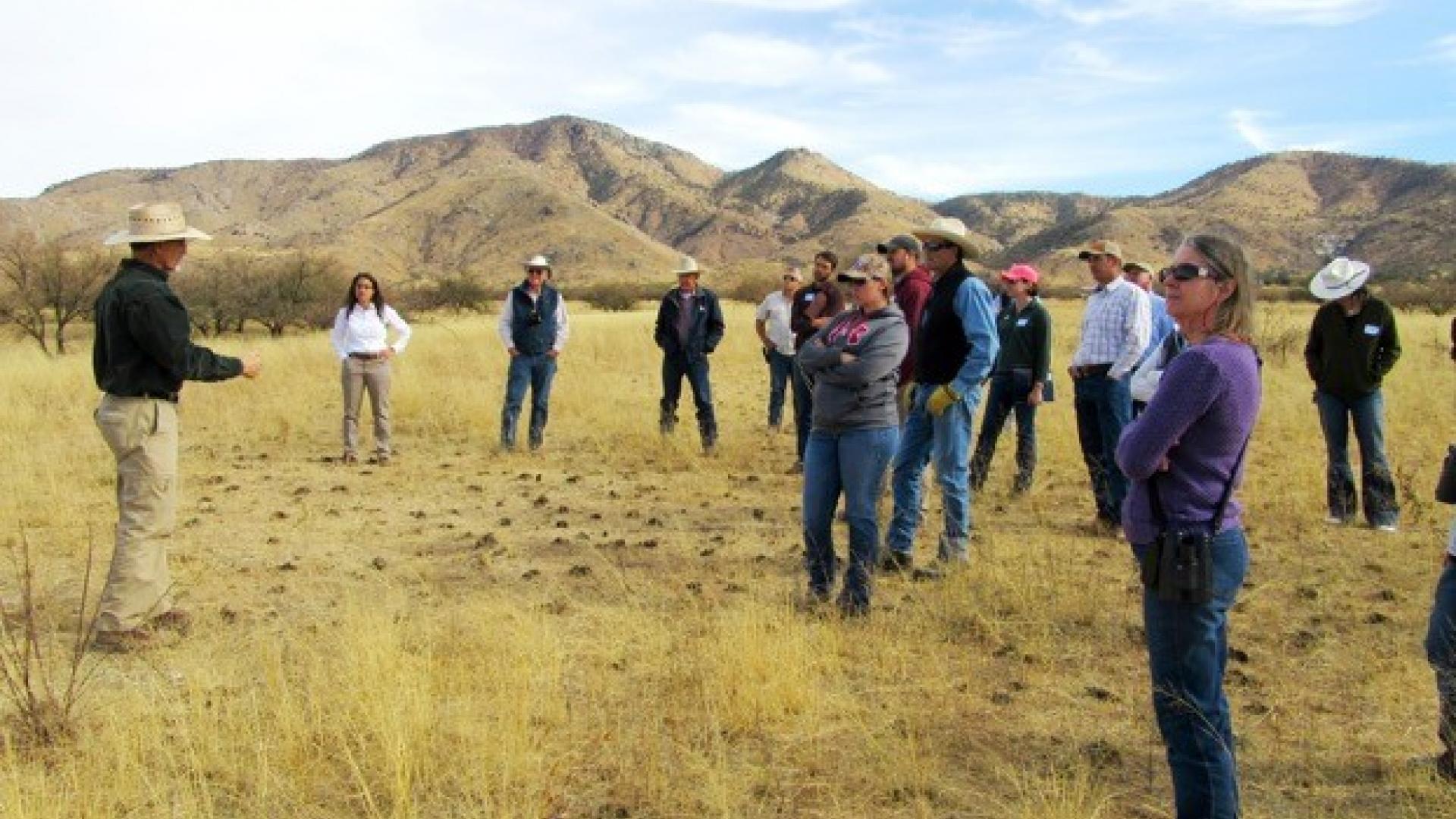
- Written by Anne Gondor, University of ArizonaBody
Much of the Western rangelands are a checkerboarded, interspersed land ownership of private, state and federal public lands. This creates difficulty in accomplishing landscape level vegetation management. One cultural tool that helps this diverse ownership with potentially conflicting opinions work together is Community-based Collaborative Conservation (Charnley, Sheridan and Nabhan 2014). These groups avert conflicts by focusing on evidence-based issues and group education (collaborative learning) in order to reach collective landscape level management decisions on shared goals regarding rangeland natural resources. Collaborative Conservation groups raise the voices of communities with concerns about impacts to their livelihoods because of environmental issues such as: landscape condition changes diminishing landscape productivity, erosion causing soil loss and water quantity and quality declines, endangered and threatened species management, wildfire mitigation and management, enforcement of regulations or fragmentation and development threats (Wilkins et al. 2020). Typically, these groups have a diverse representation of stakeholders from community members (producers, farmers and local residents) to industry and non-governmental organizations, universities as well as state and federal government agency representatives. Public land management agencies (e.g., U.S. Forest Service, Bureau of Land Management and U.S. Fish and Wildlife Service) also have cooperation and collaborative partnership policy mandates for many of their land planning processes. This brings collective action to implement rangelands maintenance and restoration solutions to often complex, cross boundary and interrelated environmental issues.
Citations see Further Reading
Related Resources
Videos
Collaborative Adaptive Landscape Management: Discussion of General Principles.
68th Annual SRM Meeting 2015, Brandon Bestlemeyer presents the general principles to collaborative adaptive landscape management (CALM).
CALM for Diverse Stakeholder Goals: A Participatory Grazing Management Experiment
Leslie Roche presents results from a participatory grazing management experiment at the 68th Annual SRM Meeting, 2015. Describing the collaborative adaptive landscape management approach for diverse stakeholder groups.
Western Collaborative Conservation Network (WCCN) Video
Center for Collaborative Conservation introduction video.
Tools
- Defenders of Wildlife. 2019. Collaborative conservation tools information hub.
- Defenders of Wildlife tool for mapping collaborative stakeholders.
Featured Resources From the Database
- Website
SUMMARY
The two-part Science Framework for Conservation and Restoration of the Sagebrush Biome published by the U.S. Forest Service Rocky Mountain Research Station is a new,…
- Journal Issue/Article
On the Ground • The same collaborative Internet technologies that fundamentally changed how businesses communicate, create products and services, and ultimately succeed have the…
Additional Links
Agricultural Research Service, USDA. 2020. Collaborative Adaptive Rangeland Management Experiment.
Bureau of Land Management. 2015. Transforming Collaborative Action and Dispute Resolution in the BLM: A Strategic Plan. Division of Decision Support, Planning and NEPA, Washington, DC.
Bureau of Land Management. BLM Collaborative Action & Dispute Resolution. Seven Principles of Successful Collaboration PowerPoint Presentation.
Conley, A., Moote, A., and Udall Center for Studies in Public Policy. 2001. Collaborative conservation in theory and practice: a literature review. Udall Center for Studies in Public Policy, the University of Arizona, Tucson, Ariz.
Fire Learning Network. 2012. Creating Nimble and Effective Collaborations for Sustainable Results PowerPoint presentation.
Further Reading
Center for Collaborative Conservation. 2017. Building Capacity for Collaborative Conservation.
Charnley, S., Sheridan, T.E., and Nabhan, G.P. 2014. Stitching the West back together: conservation of working landscapes. The University of Chicago Press, Chicago and London. USFS Review 2016. New book explores conservation of working landscapes.
Bestelmeyer, B.T., Burkett, L.M., Lister, L., Brown, J.R., and Schooley, R.L. 2019. Collaborative Approaches to Strengthen the Role of Science in Rangeland Conservation. Rangelands 41(5): 218–226.
Fernández-Giménez, M., Augustine, D., Porensky, L., Wilmer, H., Derner, J., Briske, D., and Stewart, M. 2019. Complexity fosters learning in collaborative adaptive management. Ecology and Society 24(2). The Resilience Alliance.
Fernandez-Gimenez, M., Ballard, H., and Sturtevant, V. 2008. Adaptive Management and Social Learning in Collaborative and Community-Based Monitoring: a Study of Five Community-Based Forestry Organizations in the western USA. Ecology and Society 13(2). The Resilience Alliance. doi:10.5751/ES-02400-130204.
Smedstad, J.A., and Gosnell, H. 2013. Do Adaptive Comanagement Processes Lead to Adaptive Comanagement Outcomes? A Multicase Study of Long-term Outcomes Associated with the National Riparian Service Team’s Place-based Riparian Assistance. Ecology and Society 18(4). Resilience Alliance Inc. Available from https://www.jstor.org/stable/26269389.
Wilkins, K., Pejchar, L., Carroll, S.L., Jones, M.S., Walker, S.E., Shinbrot, X.A., Huayhuaca, C., Fernández-Giménez, M.E., and Reid, R.S. 2021. Collaborative conservation in the United States: A review of motivations, goals, and outcomes. Biological Conservation 259: 109165.